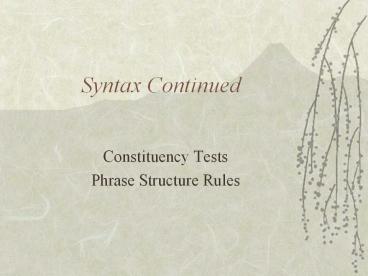Syntax Continued - PowerPoint PPT Presentation
Title:
Syntax Continued
Description:
Syntax Continued Constituency Tests Phrase Structure Rules How to determine constituency Semantic intuitions sometimes, we just know that certain strings of words go ... – PowerPoint PPT presentation
Number of Views:134
Avg rating:3.0/5.0
Title: Syntax Continued
1
Syntax Continued
- Constituency Tests
- Phrase Structure Rules
2
How to determine constituency
- Semantic intuitions
- sometimes, we just know that certain strings of
words go together as a unit. - Constituency Tests (more reliable)
- tests that can be applied to string of words in a
given sentence to determine if the string is a
constituent or not.
3
Three kinds of constituency tests
- Stand Alone Test
- Substitution Test
- Movement Test
4
Stand Alone Test
- A constituent can often be replaced by a question
expression such as who, what, where, how, why, or
do/did what. - The replaced constituent can then stand alone as
an answer to the question.
5
Stand Alone Test
- Clarice played the accordion under the table.
- Q Where did Clarice play the accordion?
- A under the table
- Clarice played the accordion under the table.
- Q Clarice played what under the table?
- A the accordion
6
Substitution Test
- Only constituents can be replaced by pro-forms.
Pro-form examples pronouns she, he, it, they,
us, her, that pro-verbs do, be pro-adverbs the
re, then, here pro-adjectives such, so, thus
7
Substitution Test
- Clarice played the accordion under the table.
- Clarice played the accordion there.
- Clarice played the accordion under the table.
- Clarice played it under the table.
- Clarice played the accordion under the table.
- Clarice did. (Who played the accordion under the
table?)
8
Movement Test
- If a string can be moved to the beginning of a
sentence, it is a constituent. - Clarice played the accordion under the table.
- Under the table, Clarice played the accordion.
- ? The accordion Clarice played under the table.
(We already know this is a constituent.) - Played the accordion under the table Clarice.
- (We already know this is a constituent.)
- Sometimes, constituency tests wont work for
strings that are actually constituents.
9
When applying const. tests, keep this in mind
- The tests arent foolproof. Often a constituent
will only pass two of the three tests. - Decide whether or not a string is a constituent
based on how convincing the test results are. - One strong pass is enough to determine
constituency in some cases.
10
When applying const. tests, keep this in mind
- We can only say whether or not a string is a
constituent relative to a particular sentence. - Time flies like an arrow.
- Fruit flies like a banana.
- We watched shooting stars all night
- The Milky Way was shooting stars from the
galactic center.
11
Phrase Structure Rules
- Our Grammar Consists of a set of rules acquired
in order to form sentences - They are formed by putting words from different
lexical categories together - PSRs (Phrase structure Rules) differ from
language to language.
12
Lexical category
- Parts of speech
- Many words, limited categories
- What you learned in school
- Noun
- Person, place or thing
- Verb
- Action word
- Adjective
- Describes something
13
But
- bad
- oops, my bad
- sandwich
- to sandwich something between two things
14
Determiners
- a, an, the, every, this, that, those, her, his,
my, yours - ______ (Adj) N
- Det
15
Nouns
- ______ plural morpheme -s
- Det (Adj) ______
- N
16
Adjectives
- ______ comparative morpheme
- more/most ______ very/quite ______
- linking verb ______ (seems, feels, is)
- Det ______ N
- A
17
Verbs
- ______ progressive morpheme -ing
- ______ past tense morpheme -ed
- auxiliary verb ______ (must, will, might)
- to ______
- ___ (NP) (PP)
- V
18
Prepositions
- at, up, over, into, above, through
- right ______ NP
- ___ NP
- P
19
Phrase Structure Rules (PSRs)
- Make observations about language
- subject and predicate (NP and VP)
- Make a rule
- S ? NP VP
- a sentence consists of an NP and a VP
20
Noun phrases (NPs)
- Cats make good pets
- NP ? N
- The book is red
- NP ? Det N
- My friendly neighbor enjoys jogging
- NP ? Det Adj N
21
Collapse the rules
- NP ? N
- NP ? Det N
- NP ? Det Adj N
- NP ? (Det) (Adj) N
22
English PSRs
- S ? NP VP
- NP ? (Det) (AP) N
- VP ? V (NP)(PP)
- AP ? (Adv) A
23
Building trees
- Words and rules
- Different ways
- top-down
- bottom-up
24
Top-down
- S
25
Top-down
- S
- VP
- NP
26
Top-down
- S
- VP
- NP NP
- V
27
Top-down
- S
- VP
- NP NP
- Det A N V Det A
N
28
Top-down
- S
- VP
- NP NP
- Det A N V Det A
N - My new roommate eats my leftover food
29
Bottom-up
- My new roommate eats my leftover food
30
Bottom-up
- Det A N V Det A N
- My new roommate eats my leftover food
31
Bottom-up
- NP NP
- Det A N V Det A N
- My new roommate eats my leftover food
32
Bottom-up
- VP
- NP NP
- Det A N V Det A
N - My new roommate eats my leftover food
33
Bottom-up
- S
- VP
- NP NP
- Det A N V Det A N
- My new roommate eats my leftover food
34
Practice Sentences
- The energetic boy ran up the hill.
- The little dog ate the biscuits.































